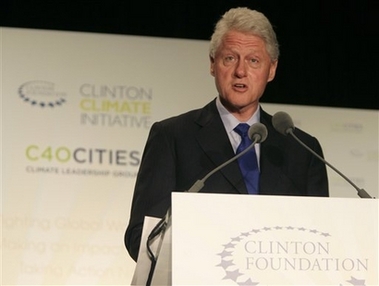16 cities to go green under Clinton plan
(AP)Updated: 2007-05-17 08:48
NEW YORK - Sixteen cities around the world will get financing to "go green" by renovating buildings they own with technology designed to cut carbon emissions, former US President Clinton announced Wednesday.
 Former president Bill Clinton speaks at a press conference announcing the creation of his global Energy Efficiency Building Retrofit Program in New York, Wednesday, May 16, 2007. [AP]  |
"If all buildings were as efficient as they could be, we'd be saving an enormous amount of energy and significantly reducing carbon emissions. Also, we'd be saving a ton of money," Clinton said.
The planned projects include replacing heating, cooling and lighting systems with energy-efficient networks; making roofs white or reflective to deflect more of the sun's heat; sealing windows and installing new models that let more light in and keep the elements out; and setting up sensors to control more efficient use of lights and air conditioning.
The former president said Citi, Deutsche Bank, JP Morgan Chase, UBS and ABN Amro have each committed $1 billion to finance the upgrades.
Clinton announced the partnership Wednesday, joined by mayors of several of the cities, as part of an international climate summit he is hosting this week in New York City with Mayor Michael Bloomberg. It is the second meeting of the C40 Large Cities Climate Summit, which was created so mayors and local governments could share strategies for reversing the trends of climate change.
"It really is groundbreaking; it really is going to make a difference," Bloomberg said.
Retrofitted buildings could see a 20 to 50 percent reduction in energy use, Clinton said.
Buildings are among a city's worst contributors to emissions totals, accounting for 50 percent of energy use in newer cities and more than 70 percent in older urban areas. In New York, for example, electricity, natural gas, fuel oil and steam consumed by buildings make up 79 percent of the city's total count of heat-trapping gases, a recent study found.
Many cities have already taken steps to "green" their municipal buildings, but the foundation said less than 1 percent of the potential market is being tapped in the US, and the efforts are less common elsewhere.
One city doing such work is Chicago. Retrofitting the lighting systems in city buildings there over the past six years has resulted in about $4 million in annual savings, said Sadhu Johnston, commissioner of the Chicago Department of the Environment.
The exact nature of the financing will be determined in coming months, the foundation said, and some details will likely differ from city to city. With the money from the banks, cities will get the green technology at no cost. The program assumes that cities already have money set aside for building operations and will pay back the bank loans, plus interest, through the energy savings that the projects achieve over several years.
To ensure those savings, Honeywell, Johnson Controls Inc., Siemens and Trane will conduct energy audits of the buildings, complete the makeovers and guarantee the energy savings. If the expected savings are not realized, those companies will pay the difference or make the changes in the buildings, the foundation said.
Warren Karlenzig, author of "How Green Is Your City?", applauded the plan and said many of these retrofits have been "crying out to happen."
"The technology is there; it's just that the financing has been missing," Karlenzig said.
The other cities taking part in the building plan are Mumbai, India; Karachi,
Pakistan; Seoul,
South Korea; Bangkok, Thailand; Melbourne, Australia; Sao
Paulo, Brazil; and Johannesburg, South Africa. The foundation expects the
partnership to expand to more cities and companies after the first round.
|
||
|
||
|
|